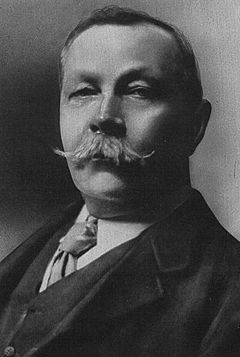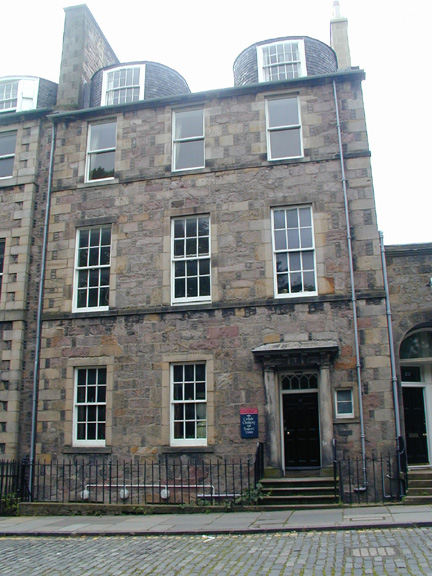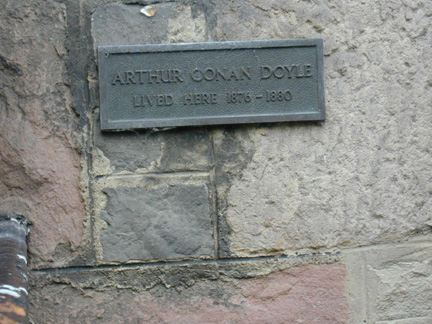THE DETECTIVES (DOYLE/HOLMES)

Sir Arthur Conan Doyle

|
| .

|
|
The house where Sir Arthur Conan Doyle lived in Edinburgh |
|
Sherlock Holmes is doubtless the most famous of all the detectives. He is followed most probably by Charlie Chan. Others include Hercule Poirot, Mr. Moto, Sam Spade, Philip Marlowe and many more. Ranging from youngsters like Frank and Joe Hardy of the Hardy Boys and Nancy Drew to the elderly Miss Marple. The first genuine detective in literature is generally felt to be the creation of Edgar Alan Poe whose character C. Auguste Dupin Le Chevalier C. Auguste Dupin made his first appearance in Poe's "The Murders in the Rue Morgue" (1841). He reappears in "The Mystery of Marie Rogêt" (1842) and "The Purloined Letter" (1844). Dupin is seen as the precursor of Sherlock Holmes
Sherlock Holmes
Sherlock Holmes was the creations of Sir Arthur Ignatius Conan Doyle born in Edinburgh 22 May 1859 – 7 July 1930). Doyle was the son of Charles Altamont Doyle, a man of Irish descent and an Irish mother. He was one of 10 children. His given names are given on his baptism certificate is Arthur Ignatius Conan and his family name simply as Doyle. His godfather is listed as Michael Conan. Despite his Catholic family he renounced Christianity to become an agnostic
(Conan) Doyle was trained in medicine at the University of Edinburgh and was impressed by one of his professor’s named JAMES BELL after whom Sherlock Holmes is in part modeled. Doyle worked as a physician thereafter. He worked as a ship’s doctor and later in a partnership and then a not too successful private practice. While waiting for patients he began to write and published his first major work, a novel: A Study in Scarlet which introduced Sherlock Holmes, his most famous creation, although he wrote some historical novels and some science fiction ones including The Lost World It was followed by another novel The Sign of the Four. The remaining 2 novels The Hound of the Baskervilles (based in part no an actual event) and The Valley of Fear came later and were published in serialized form.
Holmes is of course known for his intellectual prowess, keen powers of observation, logical reasoning and knowledge of forensic science. In some senses he is the forerunner of the more popular forensics characters of today’s films and CSI programs. Doyle’s short stories about Holmes were published in The Adventures of Sherlock Holmes, The Memoirs of Sherlock Holmes, The Return of Sherlock Holmes, His Last Bow, The Case Book of Sherlock Holmes.
Holmes became something of a nuisance to Doyle and so he killed him and his arch enemy Prof. Moriarty off in “The Final Problem”, but demand was so great he was forced to bring him back in another short story “The Adventure of the Empty House” and thereafter deal with another villain Col. Moran
NON DOYLE HOLMES STORIES
All the Holmes stories are all set in Victorian England. Any performance versions which are not, are therefore derivative.
This is the case with many of the Basil Rathbone films, possibly the best known of all the Holmes films). Between 1942 and 1946 Rathbone played Homes in 11 Holmes films and in a 12th where he has only a cameo appearance. Some of these films are based on Doyle stories but are updated to WW as propaganda film as happened with Charlie Chan as well.
IMDB lists 226 entries for film and tv appearances of the detective. The Rathbone interpretations are the best known in films, while Jeremy Brett’s interpretation is considered the finest and closest to the writings of Doyle. DOYLE wrote 56 short stories and four novels in which Holmes appears.
A number of his films were anti Nazi propaganda films and were set in WWII London, some years after Doyle had died (July 7 1930)
Other films with Holmes like Young Sherlock Holmes deal with his youth and his meeting with Watson in school. Murder by Decree sets Holmes up against Jack the Ripper. Others like The Private Life of Sherlock Holmes and The Seven and a Half Percent Solution head in different directions. Several comedies including Without a Clue and They Might Be Giants can be found an a Peter Cook version of The Hound of the Baskervilles
Doyle actually worked on two closed cases getting decisions reversed and was partially responsible for the formulation of the court of appeals
HAMMER FILMS
Hammer Film Productions is a film production company based in the United Kingdom. Founded in 1934, the company is best known for a series of Gothic "Hammer Horror" films made from the mid-1950s until the 1970s. Hammer also produced science fiction, thrillers, Film Noir and comedies – and in later years, television series. Hammer films had low budgets, but nonetheless appeared lavish, making use of quality British actors and cleverly designed sets. During its most successful years, Hammer dominated the horror film market, enjoying worldwide distribution and considerable financial success. This success was due, in part, to distribution partnerships with major United States studios, such as Warner Bros.
During the late 1960s and 1970s the saturation of the horror film market by competitors and the loss of American funding forced changes to the previously lucrative Hammer-formula, with varying degrees of success. The company eventually ceased production in the mid-1980s and since then has remained in effective hibernation. But in 2000 the studio announced plans to begin making films again after it was bought by a consortium including advertising executive and art collector Charles Saatchi, but no films have been produced. In May 2007, the company behind the movies was sold again, this time to a group headed by Big Brother creator John de Mol, the Dutch consortium Cyrte Investments, who have announced plans to spend some $50m (£25m) on new horror films. The new owners have also acquired the Hammer group's film library.
The first big success with films comes with the Quatermass films which derive from a television program wirtten by Nigek Kneale
These films were followed by the films for which the studio is perhaps most famous - the Peter Cushing Christiopher Lee horror films which derived from the old Universal horror films in the US but added color and gore. These included:

